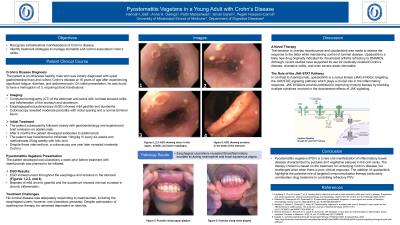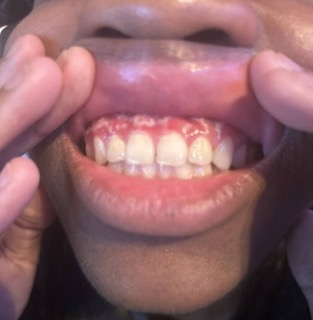Sunday Poster Session
Category: IBD
P0990 - Pyostomatitis Vegetans in a Young Adult with Crohn's Disease
Sunday, October 27, 2024
3:30 PM - 7:00 PM ET
Location: Exhibit Hall E

Has Audio

Hannah L. Bell, BS
University of Mississippi Medical Center
Jackson, MS
Presenting Author(s)
Award: Presidential Poster Award
Hannah L.. Bell, BS, Anna H.. Owings, DO, Parth Maheshwari, MD, Ismail Ganim, MD, Pegah Hosseini-Carroll, MD
University of Mississippi Medical Center, Jackson, MS
Introduction: Crohn's disease is a chronic inflammatory condition known for its diverse extraintestinal manifestations, such as erythema nodosum, aphthous ulcers, episcleritis, and peripheral arthropathy. Pyostomatitis vegetans (PSV) is a rare oral manifestation characterized by pustules and vegetative plaques in the oral cavity. This case highlights the challenges in managing PSV in a young adult with Crohn's disease.
Case Description/Methods: The patient, a 19-year-old male, was diagnosed with upper gastrointestinal and colonic Crohn’s disease at 16 years of age after experiencing significant fatigue, diarrhea, and abdominal pain. A CT of the abdomen and pelvis showed colitis and inflammation of the stomach and duodenum, confirmed by an EGD. A colonoscopy revealed moderate pancolitis with rectal sparing. Treatment with adalimumab led to a brief remission, but the patient developed antibodies to the drug after nine months. He was then switched to infliximab and methotrexate. Despite these interventions, a colonoscopy one year later showed moderate Crohn’s. Therapy with risankizumab was planned, but the patient developed oral ulcerations just before its initiation. EGD revealed ulcers in the esophagus and erosions in the stomach. Pathology identified these ulcerations as fibroinflammatory exudate, and biopsies of gastritis and the duodenum showed minimal increase in chronic inflammation. He was treated with fluconazole and a steroid taper. Dermatological assessment confirmed PSV via biopsy. The patient was prescribed a tacrolimus oral rinse and azathioprine, which was later increased to optimal dosing. Although his luminal disease responded to risankizumab, the oral ulcerations persisted, and he remained steroid-dependent.
Discussion: The development of PSV in Crohn's disease is a rare incidence, with few reported cases. Given the ongoing oral ulcerations and steroid dependence, a shift to upadacitinib was proposed. Upadacitinib, a Janus kinase (JAK) inhibitor, targets the JAK/STAT signaling pathway, which is crucial in the inflammatory response. JAK inhibitors block multiple cytokines involved in downstream effects of JAK signaling, offering potential for improved immune therapy. This case underscores the challenges of managing PSV in Crohn's disease and highlights the potential role of targeted immunomodulator therapy, particularly combination drug treatment, in controlling refractory PSV. Long-term follow-up will be essential to evaluate treatment response and disease progression.

Disclosures:
Hannah L.. Bell, BS, Anna H.. Owings, DO, Parth Maheshwari, MD, Ismail Ganim, MD, Pegah Hosseini-Carroll, MD. P0990 - Pyostomatitis Vegetans in a Young Adult with Crohn's Disease, ACG 2024 Annual Scientific Meeting Abstracts. Philadelphia, PA: American College of Gastroenterology.
Hannah L.. Bell, BS, Anna H.. Owings, DO, Parth Maheshwari, MD, Ismail Ganim, MD, Pegah Hosseini-Carroll, MD
University of Mississippi Medical Center, Jackson, MS
Introduction: Crohn's disease is a chronic inflammatory condition known for its diverse extraintestinal manifestations, such as erythema nodosum, aphthous ulcers, episcleritis, and peripheral arthropathy. Pyostomatitis vegetans (PSV) is a rare oral manifestation characterized by pustules and vegetative plaques in the oral cavity. This case highlights the challenges in managing PSV in a young adult with Crohn's disease.
Case Description/Methods: The patient, a 19-year-old male, was diagnosed with upper gastrointestinal and colonic Crohn’s disease at 16 years of age after experiencing significant fatigue, diarrhea, and abdominal pain. A CT of the abdomen and pelvis showed colitis and inflammation of the stomach and duodenum, confirmed by an EGD. A colonoscopy revealed moderate pancolitis with rectal sparing. Treatment with adalimumab led to a brief remission, but the patient developed antibodies to the drug after nine months. He was then switched to infliximab and methotrexate. Despite these interventions, a colonoscopy one year later showed moderate Crohn’s. Therapy with risankizumab was planned, but the patient developed oral ulcerations just before its initiation. EGD revealed ulcers in the esophagus and erosions in the stomach. Pathology identified these ulcerations as fibroinflammatory exudate, and biopsies of gastritis and the duodenum showed minimal increase in chronic inflammation. He was treated with fluconazole and a steroid taper. Dermatological assessment confirmed PSV via biopsy. The patient was prescribed a tacrolimus oral rinse and azathioprine, which was later increased to optimal dosing. Although his luminal disease responded to risankizumab, the oral ulcerations persisted, and he remained steroid-dependent.
Discussion: The development of PSV in Crohn's disease is a rare incidence, with few reported cases. Given the ongoing oral ulcerations and steroid dependence, a shift to upadacitinib was proposed. Upadacitinib, a Janus kinase (JAK) inhibitor, targets the JAK/STAT signaling pathway, which is crucial in the inflammatory response. JAK inhibitors block multiple cytokines involved in downstream effects of JAK signaling, offering potential for improved immune therapy. This case underscores the challenges of managing PSV in Crohn's disease and highlights the potential role of targeted immunomodulator therapy, particularly combination drug treatment, in controlling refractory PSV. Long-term follow-up will be essential to evaluate treatment response and disease progression.

Figure: Pustules along upper gingiva
Disclosures:
Hannah Bell indicated no relevant financial relationships.
Anna Owings indicated no relevant financial relationships.
Parth Maheshwari indicated no relevant financial relationships.
Ismail Ganim indicated no relevant financial relationships.
Pegah Hosseini-Carroll indicated no relevant financial relationships.
Hannah L.. Bell, BS, Anna H.. Owings, DO, Parth Maheshwari, MD, Ismail Ganim, MD, Pegah Hosseini-Carroll, MD. P0990 - Pyostomatitis Vegetans in a Young Adult with Crohn's Disease, ACG 2024 Annual Scientific Meeting Abstracts. Philadelphia, PA: American College of Gastroenterology.

